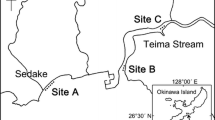Abstract
The utilization of an intertidal salt marsh creek in South Carolina during January 1977 was determined by sampling every third ebb tide for 13 days. All fishes leaving the creek during that period were captured in a channel net. This procedure produced a time-series of samples which permitted analysis of the fish community occupying the intertidal creek at all times of day and night.
A total of 14,730 larval, juvenile, and adult fishes comprising at least 22 species in 16 families were collected. The most common larval and juvenile fishes wereLeiostomus xanthurus, Mugil spp.,Myrophis punctatus leptocephali,Lagodon rhomboides, Paralichthys spp., andMicropogon undulatus. Catch sizes for all species varied widely between samples. No diurnal-nocturnal pattern in catches was evident forL. xanthurus, Mugil spp.,L. rhomboides andM. undulatus. M. punctatus was taken in large numbers only when the flood tide occurred during the day, while moreParalichthys spp. larvae were taken in late afternoon-evening flood tide samples. The most common invertebrate,Palaemonetes pugio, was taken in large quantities only in late afternoon-night flood tide samples.
Three diversity indices were computed for each sample. Values for all indices varied widely between successive samples.
The results emphasize a high degree of utilization of the intertidal creek habitat by larval and juvenile fishes. The diurnal-nocturnal activity patterns of some species, and the wide variation in catch size of the other species can permit use of the intertidal salt marsh habitat with reduced competition for available space and energy.
Similar content being viewed by others
Literature Cited
Bozeman, E. L., Jr., and J. M. Dean. In Press. Kinds and abundance of larval fish in a South Carolina intertidal creek.Estuaries.
Burns, R. W. 1974. Species abundance and diversity of larval fishes in a high-marsh tidal creek. M. S. Thesis, University of South Carolina.
Dahlberg, M. D. andE. P. Odum. 1970. Annual cycle of species occurrence, abundance, and diversity in Georgia estuarine fish populations.Am. Midl. Natur. 83:382–392.
Graham, J. J., andP. M. W. Venno. 1968. Sampling larval herring from tide-waters with buoyed and anchored nets.J. Fish. Res. Bd. Canada 25:1169–1179.
—,S. B. Chenoweth, andM. C. Miller, III. 1972. Abundance, distribution, movements and lengths of larval herring along the western coast of the Gulf of Maine.Fish. Bull. U.S. 70:307–321.
Hildebrand, S. F., andL. E. Cable. 1930. Development and life history of fourteen teleostean fishes at Beaufort, N. C.,Bull. U.S. Bur. Fish. 46:383–488.
Lewis, R. M., W. F. Hettler, Jr.,E. P. H. Wilkens, andG. N. H. Johnson. 1970. A channel net for larval fishes.Chesapeake Sci. 11:196–197.
—, andW. C. Mann. 1971. Occurrence and abundance of larval Atlantic menhaden,Brevoortia tyrannus, at two North Carolina inlets with notes on associated species.Trans. Am. Fish. Soc. 100:296–301.
— andE. P. H. Wilkens 1971. Abundance of Atlantic menhaden larvae and associated species during a diel collection at Beaufort, N. C.Chesapeake Sci. 12:185–187.
Lippson, A. J., andR. L. Moran. 1974. Manual for identification of early developmental stages of fishes of the Potomac River estuary. Environmental Technology Center. Martin-Marietta Corp., Baltimore, Maryland 21227.
Livingston, R. J. 1976. Diurnal and seasonal fluctuations of organisms in a North florida estuary.Est. Coastal Mar. Sci. 4:373–400.
McHugh, J. L. 1966. Management of estuarine fishes.Am. Fish. Soc. Spec. Publ. 3:133–154.
Pacheco, A. L. 1973. Range and distribution of some estuarine fishes: striped mullet and white mullet, p. 267.In A. L. Pacheco (ed.), Proceedings of a Workshop on Egg, Larval, and Juvenile Stages of Fish in Atlantic Coast Estuaries. Natl. Mar. Fish. Serv., Mid. Atl. Coast. Fish. Center, Tech. Publ. 1, Highlands, N.J. 338 p.
Reis, R. 1977. Variations in utilization of a high marsh intertidal creek by larval and juvenile fish. M. S. Thesis, University of South Carolina.
Subrahmanyan, C. B., andS. H. Drake. 1975. Studies on the animal communities in two, North Florida salt marshes. Part 1. Fish communities.Bull. Mar. Sci 25: 445–465.
Wilkens, E. P. H., andR. M. Lewis. 1971. Abundance and distribution of young Atlantic menhaden,Brevoortia tyrannus, in the White Oak River estuary, North Carolina.Fish. Bull. U. S. 69:783–789.
Author information
Authors and Affiliations
Rights and permissions
About this article
Cite this article
Shenker, J.M., Dean, J.M. The utilization of an intertidal salt marsh creek by larval and juvenile fishes: Abundance, diversity and temporal variation. Estuaries 2, 154–163 (1979). https://doi.org/10.2307/1351729
Issue Date:
DOI: https://doi.org/10.2307/1351729




